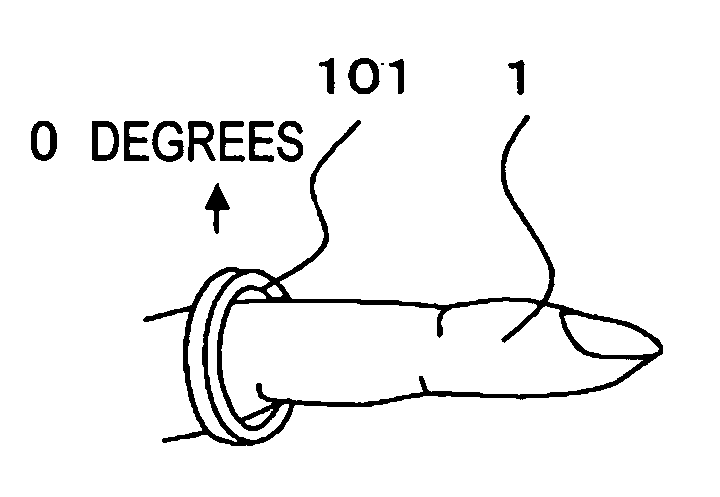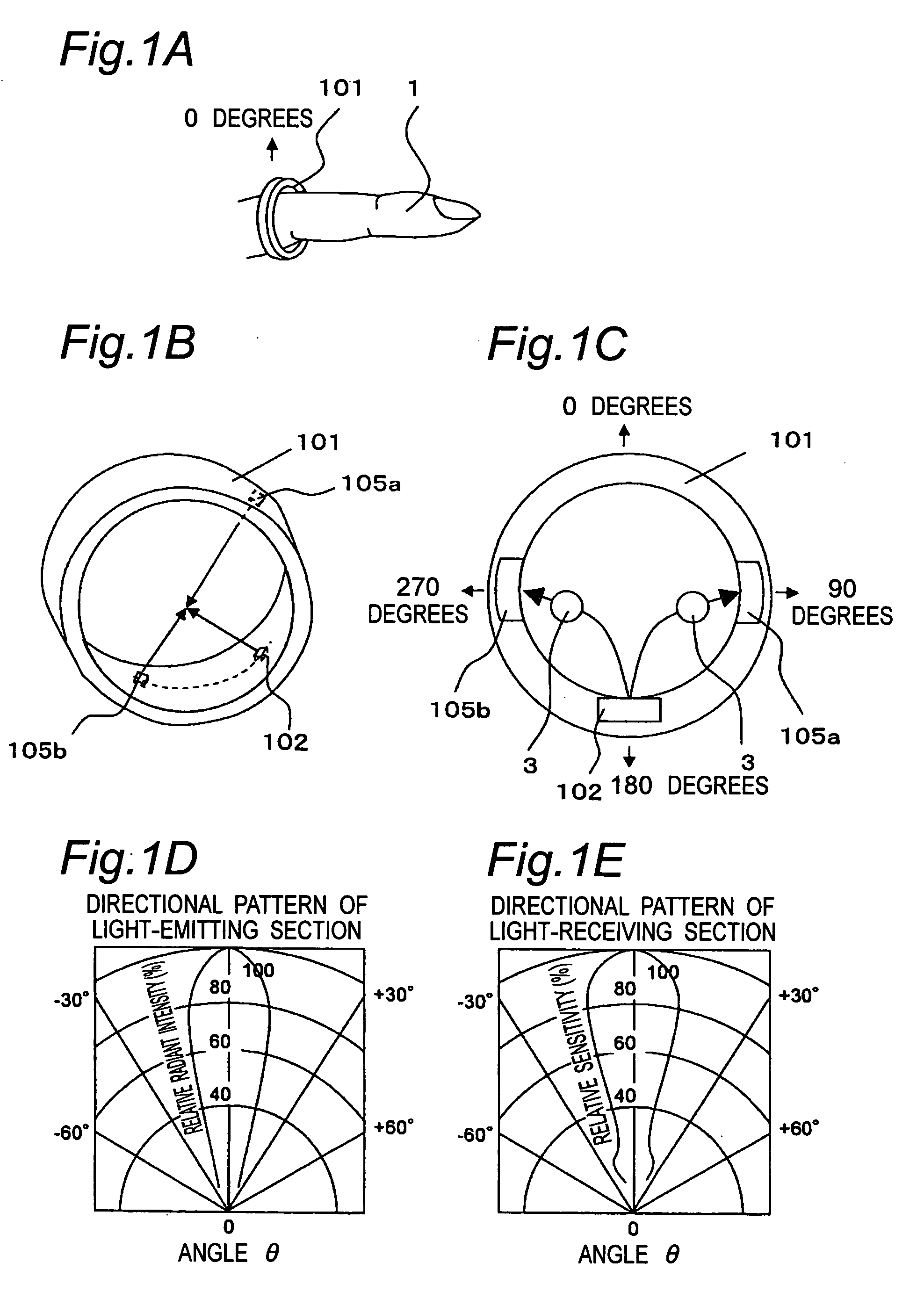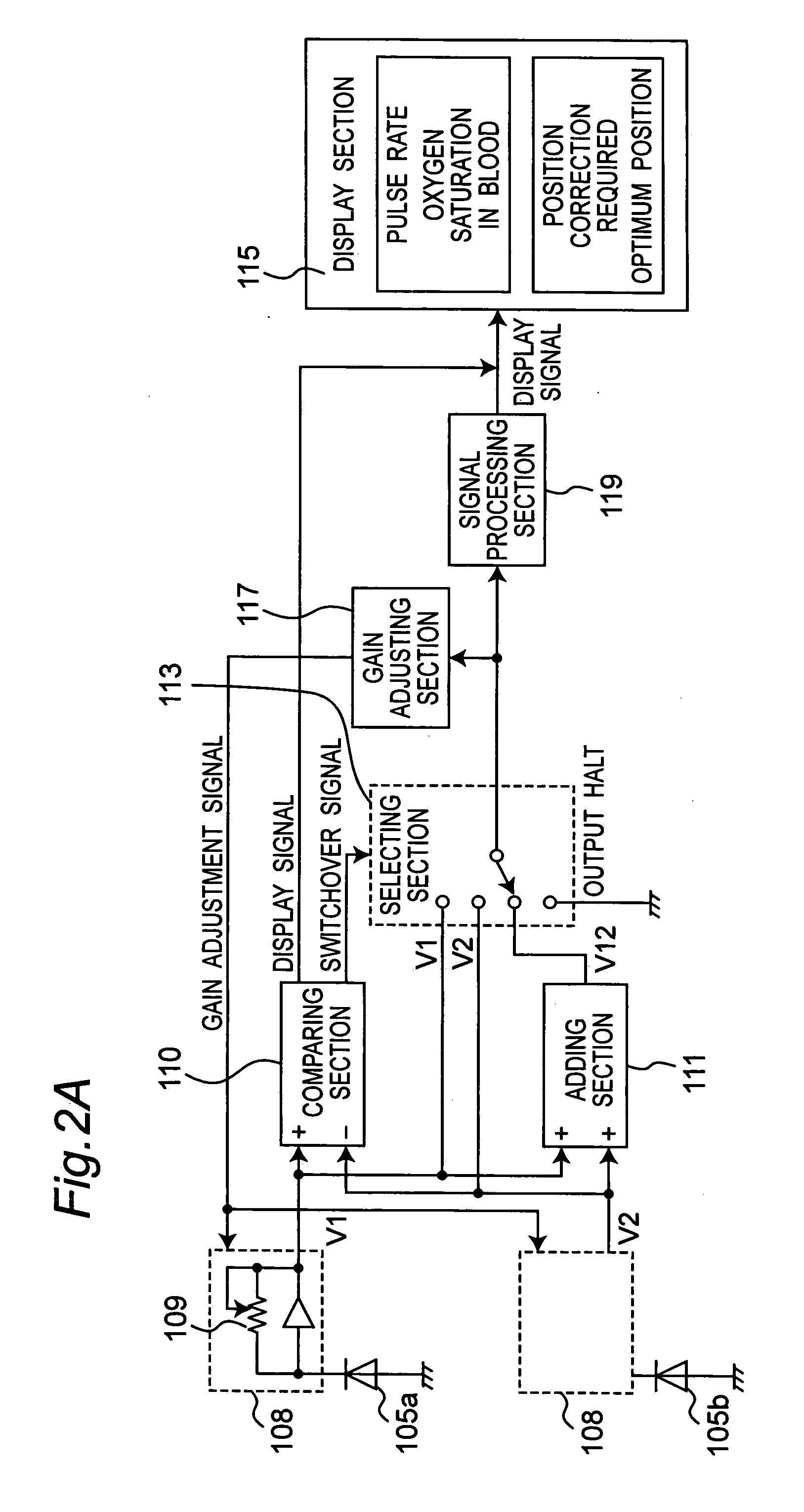Detector
a detection device and detector technology, applied in the field of sensors, can solve the problems of low signal-noise ratio, poor light-receiving efficiency, low temperature burn on the human body, etc., and achieve the effect of suppressing the decrease in signal-noise ratio, reducing the amount of light emission for each light-emitting section, and improving light-receiving efficiency
- Summary
- Abstract
- Description
- Claims
- Application Information
AI Technical Summary
Benefits of technology
Problems solved by technology
Method used
Image
Examples
embodiment 1
[0057] (Embodiment 1)
[0058]FIGS. 1A to 1E are views about a ring sensor in an embodiment 1.
[0059] As shown in FIG. 1A, a ring sensor 101, which is a finger ring-type ring, is worn on the base of a finger 1. A ring size is appropriately selected according to the size of a finger of each user so that the inner circumferential surface of the ring is constantly in close contact with the finger.
[0060]FIGS. 1B and 1C show the inner circumferential surface and the cross section of the ring sensor. On the inner circumferential surface, there are a light-emitting section 102 formed from a light-emitting diode, and first and second light-receiving sections 105a, 105b formed from photodiodes. The light-emitting section 102 has a light-emitting diode for emitting red light and a light-emitting diode for emitting infrared light.
[0061]FIG. 1D shows an example of the directional patterns of the light-emitting section and the light-receiving section. The light-emitting section 102 and the respec...
embodiment 2
[0097] (Embodiment 2)
[0098]FIGS. 3A to 3D are views about a ring sensor in an embodiment 2.
[0099] It is to be noted that as for the structure of the embodiment 2, explanation about structure components identical to those in the embodiment 1 shown in FIGS. 1A to 1E and FIGS. 2A to 2B is omitted and their differences are mainly described.
[0100] In FIGS. 3A and 3B, a light-emitting section 202 is formed on the inner circumferential surface of a ring sensor 201, and first and second light-receiving sections 205a, 205b are formed at positions symmetric to a light-emitting axis of the light-emitting section 202. More specifically, the first and second light-receiving sections 205a, 205b are placed at positions facing each other on the inner circumferential surface of the ring sensor 201.
[0101] Moreover, a light-emitting point of the light-emitting section 202 and respective light-receiving points of the first and second light-receiving sections 205a, 205b are placed at tracks different...
embodiment 3
[0105] (Embodiment 3)
[0106]FIG. 4A is a perspective view showing a ring sensor in a worn state in an embodiment 3 of the present invention, and FIG. 4B is a transverse sectional view showing the ring sensor.
[0107] It is to be noted that as for the structure of the embodiment 3, explanation about structure components identical to those in the embodiments 1 and 2 shown in FIGS. 1A to 1E and FIGS. 3A to 3D is omitted and their differences are mainly described.
[0108] First and second light-receiving sections 305a, 305b are respectively divided into light-receiving regions a, b, c and A, B, C.
[0109] The respective light receiving regions are formed along the inner circumferential surface of the ring in a circumferential direction in the order of a, b, c and A, B, C from the farthest side from the a light-emitting section 302.
[0110] In FIG. 4B, the light-emitting section 302 is formed on the inner circumferential surface of a ring sensor 301, and the first and second light-receiving s...
PUM
 Login to View More
Login to View More Abstract
Description
Claims
Application Information
 Login to View More
Login to View More - R&D
- Intellectual Property
- Life Sciences
- Materials
- Tech Scout
- Unparalleled Data Quality
- Higher Quality Content
- 60% Fewer Hallucinations
Browse by: Latest US Patents, China's latest patents, Technical Efficacy Thesaurus, Application Domain, Technology Topic, Popular Technical Reports.
© 2025 PatSnap. All rights reserved.Legal|Privacy policy|Modern Slavery Act Transparency Statement|Sitemap|About US| Contact US: help@patsnap.com



